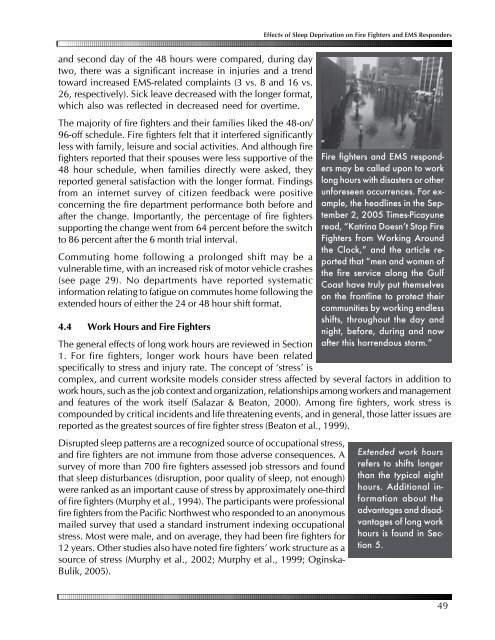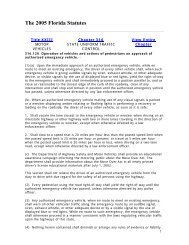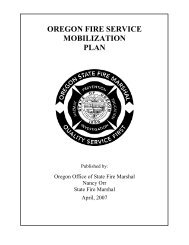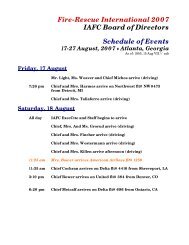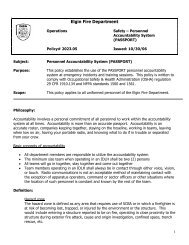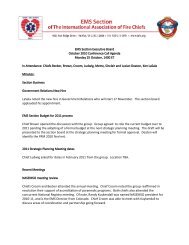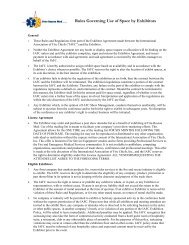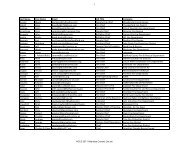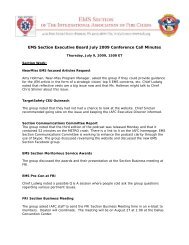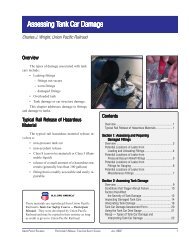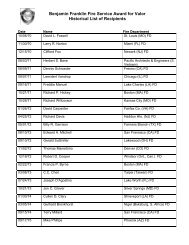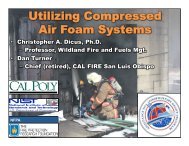Effects of Sleep Deprivation on Fire Fighters and EMS ... - NAEMT
Effects of Sleep Deprivation on Fire Fighters and EMS ... - NAEMT
Effects of Sleep Deprivation on Fire Fighters and EMS ... - NAEMT
Create successful ePaper yourself
Turn your PDF publications into a flip-book with our unique Google optimized e-Paper software.
<str<strong>on</strong>g>Effects</str<strong>on</strong>g> <str<strong>on</strong>g>of</str<strong>on</strong>g> <str<strong>on</strong>g>Sleep</str<strong>on</strong>g> <str<strong>on</strong>g>Deprivati<strong>on</strong></str<strong>on</strong>g> <strong>on</strong> <strong>Fire</strong> <strong>Fighters</strong> <strong>and</strong> <strong>EMS</strong> Resp<strong>on</strong>ders<br />
<strong>and</strong> sec<strong>on</strong>d day <str<strong>on</strong>g>of</str<strong>on</strong>g> the 48 hours were compared, during day<br />
two, there was a significant increase in injuries <strong>and</strong> a trend<br />
toward increased <strong>EMS</strong>-related complaints (3 vs. 8 <strong>and</strong> 16 vs.<br />
26, respectively). Sick leave decreased with the l<strong>on</strong>ger format,<br />
which also was reflected in decreased need for overtime.<br />
The majority <str<strong>on</strong>g>of</str<strong>on</strong>g> fire fighters <strong>and</strong> their families liked the 48-<strong>on</strong>/<br />
96-<str<strong>on</strong>g>of</str<strong>on</strong>g>f schedule. <strong>Fire</strong> fighters felt that it interfered significantly<br />
less with family, leisure <strong>and</strong> social activities. And although fire<br />
fighters reported that their spouses were less supportive <str<strong>on</strong>g>of</str<strong>on</strong>g> the<br />
48 hour schedule, when families directly were asked, they<br />
reported general satisfacti<strong>on</strong> with the l<strong>on</strong>ger format. Findings<br />
from an internet survey <str<strong>on</strong>g>of</str<strong>on</strong>g> citizen feedback were positive<br />
c<strong>on</strong>cerning the fire department performance both before <strong>and</strong><br />
after the change. Importantly, the percentage <str<strong>on</strong>g>of</str<strong>on</strong>g> fire fighters<br />
supporting the change went from 64 percent before the switch<br />
to 86 percent after the 6 m<strong>on</strong>th trial interval.<br />
Commuting home following a prol<strong>on</strong>ged shift may be a<br />
vulnerable time, with an increased risk <str<strong>on</strong>g>of</str<strong>on</strong>g> motor vehicle crashes<br />
(see page 29). No departments have reported systematic<br />
informati<strong>on</strong> relating to fatigue <strong>on</strong> commutes home following the<br />
extended hours <str<strong>on</strong>g>of</str<strong>on</strong>g> either the 24 or 48 hour shift format.<br />
4.4 Work Hours <strong>and</strong> <strong>Fire</strong> <strong>Fighters</strong><br />
The general effects <str<strong>on</strong>g>of</str<strong>on</strong>g> l<strong>on</strong>g work hours are reviewed in Secti<strong>on</strong><br />
1. For fire fighters, l<strong>on</strong>ger work hours have been related<br />
specifically to stress <strong>and</strong> injury rate. The c<strong>on</strong>cept <str<strong>on</strong>g>of</str<strong>on</strong>g> ‘stress’ is<br />
complex, <strong>and</strong> current worksite models c<strong>on</strong>sider stress affected by several factors in additi<strong>on</strong> to<br />
work hours, such as the job c<strong>on</strong>text <strong>and</strong> organizati<strong>on</strong>, relati<strong>on</strong>ships am<strong>on</strong>g workers <strong>and</strong> management<br />
<strong>and</strong> features <str<strong>on</strong>g>of</str<strong>on</strong>g> the work itself (Salazar & Beat<strong>on</strong>, 2000). Am<strong>on</strong>g fire fighters, work stress is<br />
compounded by critical incidents <strong>and</strong> life threatening events, <strong>and</strong> in general, those latter issues are<br />
reported as the greatest sources <str<strong>on</strong>g>of</str<strong>on</strong>g> fire fighter stress (Beat<strong>on</strong> et al., 1999).<br />
Disrupted sleep patterns are a recognized source <str<strong>on</strong>g>of</str<strong>on</strong>g> occupati<strong>on</strong>al stress,<br />
<strong>and</strong> fire fighters are not immune from those adverse c<strong>on</strong>sequences. A<br />
survey <str<strong>on</strong>g>of</str<strong>on</strong>g> more than 700 fire fighters assessed job stressors <strong>and</strong> found<br />
that sleep disturbances (disrupti<strong>on</strong>, poor quality <str<strong>on</strong>g>of</str<strong>on</strong>g> sleep, not enough)<br />
were ranked as an important cause <str<strong>on</strong>g>of</str<strong>on</strong>g> stress by approximately <strong>on</strong>e-third<br />
<str<strong>on</strong>g>of</str<strong>on</strong>g> fire fighters (Murphy et al., 1994). The participants were pr<str<strong>on</strong>g>of</str<strong>on</strong>g>essi<strong>on</strong>al<br />
fire fighters from the Pacific Northwest who resp<strong>on</strong>ded to an an<strong>on</strong>ymous<br />
mailed survey that used a st<strong>and</strong>ard instrument indexing occupati<strong>on</strong>al<br />
stress. Most were male, <strong>and</strong> <strong>on</strong> average, they had been fire fighters for<br />
12 years. Other studies also have noted fire fighters’ work structure as a<br />
source <str<strong>on</strong>g>of</str<strong>on</strong>g> stress (Murphy et al., 2002; Murphy et al., 1999; Oginska-<br />
Bulik, 2005).<br />
<strong>Fire</strong> fighters <strong>and</strong> <strong>EMS</strong> resp<strong>on</strong>ders<br />
may be called up<strong>on</strong> to work<br />
l<strong>on</strong>g hours with disasters or other<br />
unforeseen occurrences. For example,<br />
the headlines in the September<br />
2, 2005 Times-Picayune<br />
read, “Katrina Doesn’t Stop <strong>Fire</strong><br />
<strong>Fighters</strong> from Working Around<br />
the Clock,” <strong>and</strong> the article reported<br />
that “men <strong>and</strong> women <str<strong>on</strong>g>of</str<strong>on</strong>g><br />
the fire service al<strong>on</strong>g the Gulf<br />
Coast have truly put themselves<br />
<strong>on</strong> the fr<strong>on</strong>tline to protect their<br />
communities by working endless<br />
shifts, throughout the day <strong>and</strong><br />
night, before, during <strong>and</strong> now<br />
after this horrendous storm.”<br />
Extended work hours<br />
refers to shifts l<strong>on</strong>ger<br />
than the typical eight<br />
hours. Additi<strong>on</strong>al informati<strong>on</strong><br />
about the<br />
advantages <strong>and</strong> disadvantages<br />
<str<strong>on</strong>g>of</str<strong>on</strong>g> l<strong>on</strong>g work<br />
hours is found in Secti<strong>on</strong><br />
5.<br />
49


